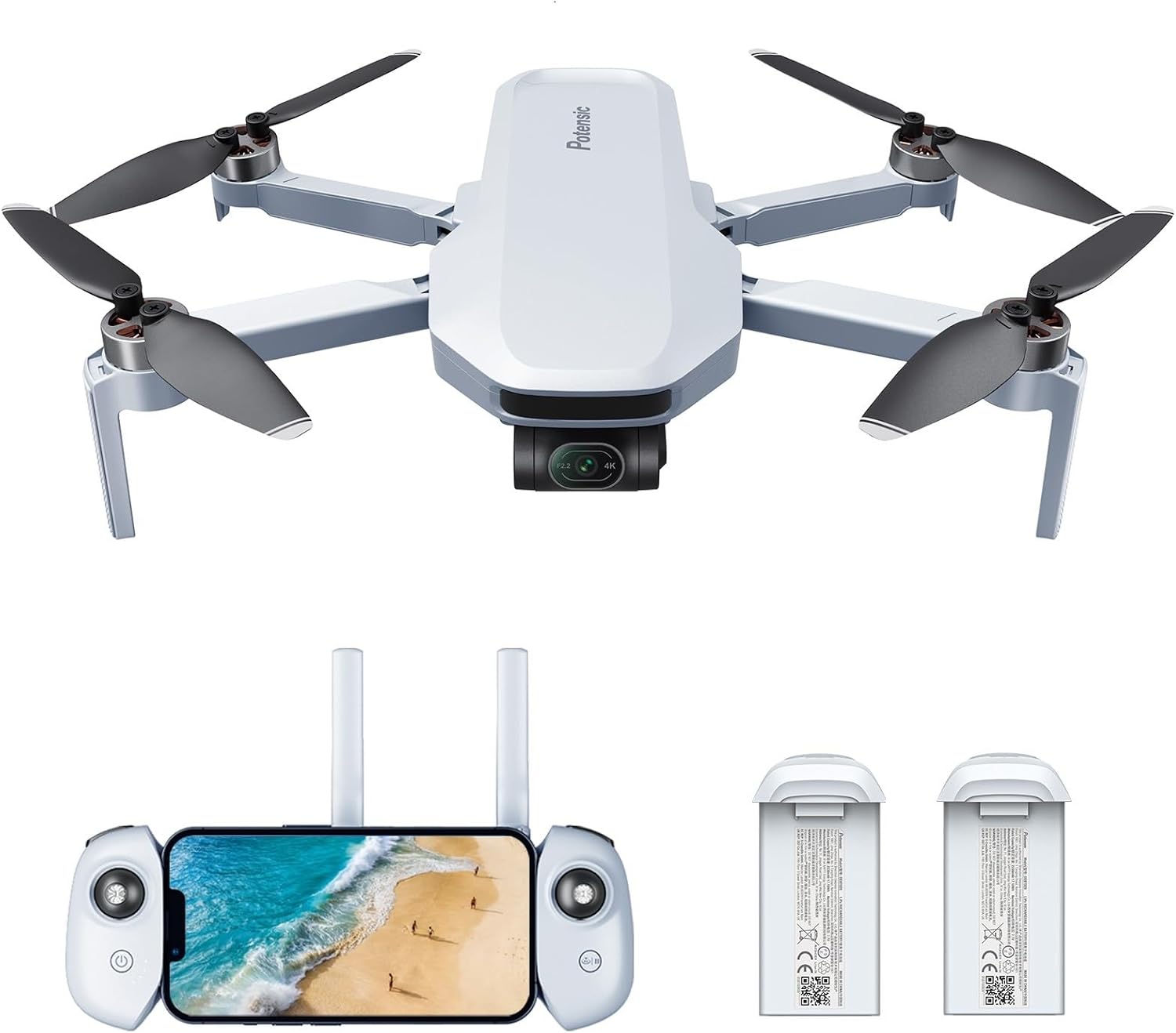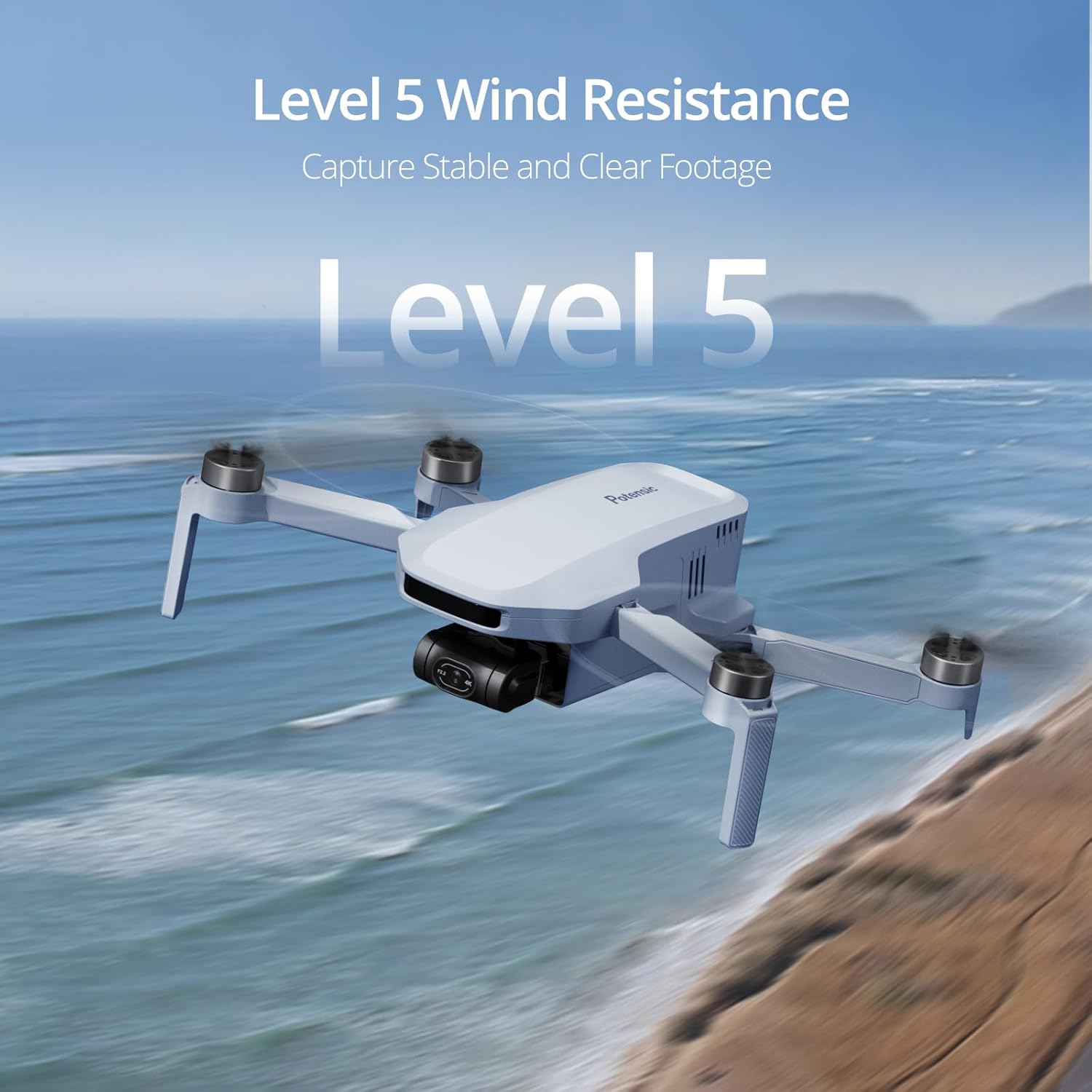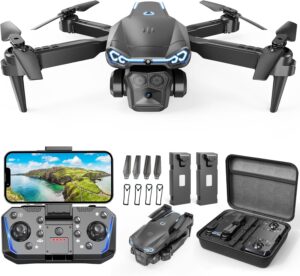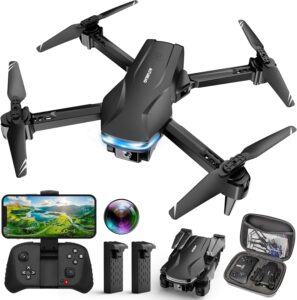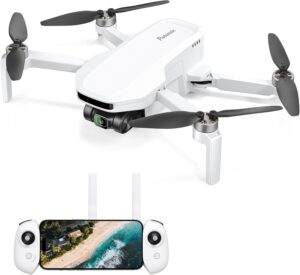Can we write in the exact style of David Sedaris? We can’t, but we’ll bring a warm, witty, gently self-deprecating tone with sharp observations and friendly humor to keep things lively while we review this drone together.
What We Wanted From the Potensic ATOM
We were looking for a compact drone that doesn’t saddle us with extra paperwork yet still feels competent in the sky. Our wish list was simple: steady 4K footage, reassuring GPS, and enough intelligent features to film ourselves without recruiting a friend to stand around holding a remote.
The Potensic ATOM, 3-Axis Gimbal 4K Drone with Camera for Adults, Under 249g, 64 Mins Flight, Max 6KM Transmission, Visual Tracking, 4K/30FPS QuickShots, Expansion Kit promised to tick all of those boxes. We gave it a thorough workout to see whether it’s a travel-friendly companion or a fair-weather acquaintance that only shines in the spec sheet.
Potensic ATOM, 3-Axis Gimbal 4K Drone with Camera for Adults, Under 249g, 64 Mins Flight, Max 6KM Transmission, Visual Tracking, 4K/30FPS QuickShots, Expansion Kit
$299.99 In Stock
Unboxing and First Impressions
We unfolded the arms and did that habitual preflight ritual: admire, squint, and try to remember if we charged the batteries. The ATOM’s foldable, palm-sized frame makes a strong first impression—it’s light enough to tuck in a small bag, sturdy enough not to feel like a disposable toy.
The Expansion Kit includes two batteries, which immediately eased our range anxiety. We didn’t find ourselves rationing flight time like it was a bag of fancy airport almonds. With everything snapped together, the drone looks clean and modern, the gimbal snug, and the build quality more “capable gadget” than “fragile novelty.”
Design and Build Quality
We appreciate that the ATOM weighs under 249 grams. In the United States, that generally means no FAA registration for recreational flights, and if we’re not registering, we’re not worrying about Remote ID either. If we’re flying under Part 107 (commercial), we still need to register regardless of weight, and rules vary by country, so it’s worth checking local regulations before liftoff.
The construction feels thoughtfully engineered: the foldable arms lock out confidently, the brushless motors spin up smoothly, and the 3-axis gimbal sits protected behind a clear guard. It won’t bully a gale into submission, but it’s rated for level-5 winds, which translates to holding its own in breezes that send paper plates skittering.
Setup, Firmware, and App Experience
We updated the firmware over the air (FOTA), which we appreciated. We’re big fans of products that improve after purchase, and everything from flight stability to transmission quality benefits when manufacturers keep polishing the software.
The initial setup felt straightforward: app installed, batteries topped up, a quick compass and IMU calibration, and off we went. The app’s interface is friendly, with clear on-screen prompts, prominent RTH (return-to-home) controls, and an easy path to switching between modes. It’s not the busiest app we’ve used, and we mean that in a good way—the essentials are easy to find when our brain is juggling sky, wind, and battery percentages.
Camera and Gimbal Performance
The headline here is a 12MP camera capturing 4K at 30 frames per second on a 3-axis brushless gimbal. This combo does a lot of heavy lifting, smoothing out the jitters and giving our footage that floating-on-rails look, even when gusts tried to play hobbyist meteorologist with our plans.
In good light, the ATOM produces crisp video with pleasing color and respectable dynamic range. High-contrast scenes are handled gracefully, and we rarely needed to rescue highlights or shadows afterward. Low-light is serviceable for scenic twilights and city glow, but like most sub-250g drones, it prefers sunshine to sodium vapor street lamps. Still, the gimbal’s stability really helps in dusk situations where the sensor is working harder.
Photo Quality and Controls
We rattled off lots of stills, tapping into the 12MP resolution. We found the images clean and easily shareable without heavy editing. We liked having straightforward controls for exposure and white balance, and we appreciated that the gimbal reacted predictably to horizon bumps. We did wish for more advanced photo modes or flat/log video profiles, but the target audience here is more “film our vacation without anxiety” than “color-grade a festival documentary.”
Gimbal Confidence in Real Wind
On a blustery afternoon, we pushed the ATOM to see if the footage would wobble like a handheld time capsule from the ‘90s. The gimbal kept the horizon locked and the jitters tame, and we felt confident flying near trees without fearing a sudden tilt or panic drop. It’s not invincible—you’ll still see micro-adjustments in strong gusts—but the stability far exceeds what we expected at this size and price.
Flight Performance and Controls
Our hands felt at home on the controller, which is intuitive and stable. The sticks have a friendly learning curve: gentle enough for beginners and suitably precise for those of us who like to arc a shot just-so while pretending to be aerial choreographers.
Hovering accuracy impressed us. The ATOM didn’t wander like it had a secret appointment elsewhere. Transitions from hover to motion were smooth, braking was firm but not abrupt, and the overall flight character felt composed. We did our share of quick spins and direction changes and never coaxed out a topple or an alarming shimmy.
Speed, Wind, and Obstacle Notes
We’d call the top speed “spirited.” It has enough pep to reposition quickly for a shot or scoot home ahead of a falling battery bar. It’s worth noting that this drone doesn’t advertise multi-direction obstacle avoidance sensors. We flew conservatively around branches and light poles, which is our general practice anyway. GPS, solid braking, and a sharp eye are the real safety team here.
Transmission Range and Reliability
Potensic’s PixSync 3.0 promises up to 6KM of transmission, and we saw a stable, low-latency video feed that inspired trust. As always, local regulations, line-of-sight rules, and interference will shape what we can—and should—do with that range. We kept our tests responsible and line-of-sight, and we appreciated a clear feed in open areas where other drones have coughed at the first sign of Wi-Fi congestion.
In suburban spots with mild interference, we still maintained a dependable link. The real-world transmission felt competitive and confidence-inspiring, and we weren’t babysitting the signal while trying to compose our shots.
Intelligent Features: Visual Tracking and QuickShots
Visual Tracking is one of those modern wonders that make us feel like our gadgets have evolved into considerate companions. We boxed ourselves on screen, started walking, and watched as the ATOM followed with decent steadiness, doing its best paparazzi impression without the awkward small talk.
The QuickShots—Pull-Away, Rocket, Circle, Spiral, and Boomerang—are pre-programmed camera moves that add cinematic flair by pressing a button instead of renting a crane. We loved the Circle for highlighting interesting scenery, and Boomerang gave us that smooth pull-out and return that makes even a picnic look heroic. We still kept our eyes open and our area clear; these are smart routines, not magic. If there’s a tree in the way, the tree will win.
Tracking Reliability and Best Practices
Tracking works best when the subject is distinct from the background and movement isn’t frantic. We had the best results in open spaces with consistent lighting. We avoided running beneath dense canopy or in tight alleys, since GPS and line-of-sight matter as much as the algorithms. When we treated the drone like a helpful assistant rather than a mind reader, our clips looked polished and intentional.
Battery Life and Charging
With two 2330mAh intelligent batteries in the Expansion Kit, Potensic claims up to 64 minutes of total flight time. In practice, with real wind and our irresistible urge to hit record, we got slightly less per battery, which is exactly how the world works. Still, two batteries gave us the freedom to try multiple takes and wander beyond the playground.
Charging is straightforward and modern—no fiddly proprietary puzzles. We made a habit of topping everything off the night before a flight so we never had to ration in the field. It’s always worth checking battery temps after a vigorous session; we found them warm but not worrisome.
Battery Tips We Learned
- Rotate batteries evenly so one doesn’t become the “favorite” and wear faster.
- Land with a buffer—don’t push down to the last percent in wind or cold.
- Store batteries partially charged (around 40–60%) if we’re taking a break from flying for a week or more.
GPS, Return-to-Home, and Safety
The enhanced GPS and Return-to-Home (RTH) system are the quiet heroes here. We set the home point, watched satellite counts climb, and rested easier knowing a single tap could send the ATOM back to its starting place.
We tested RTH in three scenarios: manual trigger, low-battery prompt, and a temporary signal cut. The drone climbed to the preset RTH altitude and returned in a tidy line like it had an appointment. Precision landing is not a promised feature, so while it came back close to the pad, we didn’t expect it to kiss the “H” every time. It was consistent and safe, which is exactly what we want.
Safety Reminders We Actually Use
- We set RTH altitude above the tallest nearby obstacle. We measure with our eyes and then add a safety margin.
- We confirm satellites and home-point set before flying more than a stone’s throw away.
- We keep a mental map of wind direction so RTH doesn’t fight a headwind the whole way home.
Noise, Wind, and Weather Behavior
The ATOM produces the familiar high-pitched whir of small drones, but it’s not obnoxious. At a modest distance, it blends into ambient outdoor noise. We avoided flying directly over people, which is safer and also friendlier to nerves.
In wind, that level-5 rating felt honest. We wouldn’t try to film a kite festival during a gust front, but we didn’t feel bullied by breezes either. As for rain and snow: it’s not a waterproof drone. We kept it dry because nothing ruins a day like explaining to a tiny camera why it should enjoy a bath.
Accessories and the Expansion Kit
The Expansion Kit’s star is the second battery, which doubles flight opportunities without packing more charging gear. We also appreciated the typical extras we associate with such kits—spare props, tools, and carrying niceties—though specifics vary by package and retailer, so we check the listing to avoid surprises.
We’d add a high-speed microSD card to complete the kit. A U3-rated card (or better) keeps 4K footage happy. We formatted cards in the app before recording big sessions to minimize file hiccups.
Transmission, Interference, and Legal Considerations
We kept our flights within visual line-of-sight and respected local radio rules. Even with a long-range spec, laws and common sense guide how far we go. We favored open fields and parks (where permitted) and stayed away from airports, restricted zones, and places where a drone might spook wildlife or people.
When interference crept in—say, near dense housing—we kept our altitude reasonable and avoided placing buildings between us and the drone. Line-of-sight is not just a legal checkbox; it’s a technical advantage for stable transmission.
Creative Possibilities with 4K and QuickShots
We used the ATOM to make simple videos feel designed rather than incidental. A slow Circle around a statue made it look monumental. A Rocket shot from a picnic table turned a lazy afternoon into a scene that practically begged for orchestral music.
We also enjoyed stringing QuickShots into a sequence: a Pull-Away to set the scene, a Circle to add depth, and a Boomerang to return close for a tying detail. With stable 4K/30, the footage cuts together easily, and we didn’t spend hours stabilizing or apologizing to our friends for shaky hands.
App Features and Usability Notes
The app is pleasantly minimal, which helps when we’re managing wind, light, and battery. We liked the clear flight telemetry, the simplicity of setting RTH altitude, and the frictionless way to trigger QuickShots. Firmware updates through FOTA were quick and unproblematic for us.
We’d love more granular camera controls and profiles for advanced users, but the trade-off keeps the learning curve shallow. We didn’t find ourselves lost in menus or tapping through arcane sub-screens to find basic functions.
Who It’s For (and Who Will Want More)
We see the Potensic ATOM as a friendly choice for travelers, casual creators, and anyone who wants a fuss-free way to film themselves without carrying a backpack full of gear. It’s also a comfortable entry for beginners who care about image quality and want the safety net of GPS and RTH.
If we’re working on professional projects that demand 10-bit color, log profiles, multi-direction obstacle avoidance, or advanced subject detection, we’d need a higher-tier platform. If we just want to learn the basics and post great-looking clips without a steep cost or paperwork, this drone feels like a sweet spot.
Comparisons We Considered
We weighed the ATOM against popular sub-250g options. DJI’s Mini 2 SE keeps costs low but caps video at 2.7K, which matters if we’re committed to 4K. DJI’s Mini 3 and Mini 3 Pro push further with sensor upgrades, vertical shooting, and obstacle avoidance in some models, but they also push the price higher.
The ATOM sits in a savvy niche: true 4K/30 with a 3-axis gimbal, reliable GPS and RTH, visual tracking and QuickShots, and a light footprint that reduces bureaucratic friction for many recreational pilots. For the price, the value proposition is compelling.
Tips for Getting the Best Footage
We collected small habits that paid big dividends in the final clips. These didn’t require studio know-how, just patience and a little preparation.
- Scout the wind: we launch from a spot where gusts are lowest and obstacles sparse.
- Set RTH altitude early: we double-check this setting every session.
- Shoot during golden hour: the sensor loves soft light, and so do we.
- Consider ND filters: in bright sun, an ND can help keep motion silky at 30 fps.
- Practice the gimbal wheel: slow tilts and pans elevate ordinary scenes.
- Fly paths twice: the second take is almost always smoother.
- Keep the horizon level: a quick gimbal recalibration saves editing headaches.
Troubleshooting and Quirks
No drone is above the occasional mood swing. We faced a few manageable issues and found workable solutions.
- GPS lock delays: sometimes the drone needed an extra minute to grab satellites; we waited patiently and kept the drone stationary until the count looked healthy.
- Gimbal calibration: after a bumpy ride in a bag, a quick recalibration straightened the horizon.
- MicroSD card errors: lower-speed cards caused recording hiccups; switching to a U3 card fixed it.
- Firmware nudge: after a glitchy app reconnect, we updated the firmware and the issue vanished.
- Wind wobbles: if gusts made the drone twitchy, we shortened our paths, shot lower, and leaned on QuickShots.
Safety, Etiquette, and Peace of Mind
We kept a low profile and stayed courteous. We avoided flying over people, gave wildlife a wide berth, and chose locations where the drone wouldn’t become the center of attention. We’ve found that a friendly wave and a landing when someone seems uncomfortable goes a long way toward good community vibes.
The RTH safety net builds confidence, but we still maintain manual skills. We practice line-of-sight maneuvers in open spaces so if the tech hiccups, our hands know exactly what to do.
Value, Warranty, and Long-Term Outlook
The ATOM’s value grows with each firmware update, and Potensic’s FOTA approach suggests a product that won’t stagnate. We’d expect a standard manufacturer warranty through Potensic and retailer protections as well; specifics vary by region and seller, so we double-check those details before purchasing.
Over time, the wear points are batteries, props, and inevitably the microSD card we once dropped under the car seat. Replacement props and batteries are typically available, and we consider a second set of props insurance against an ambitious landing.
Specifications at a Glance
We put the essentials in one place to make quick comparisons easier. Some details aren’t explicitly disclosed by the manufacturer, and we don’t guess where we don’t know.
| Feature | Potensic ATOM Details |
|---|---|
| Weight | Under 249 g (no FAA registration typically required for recreational flight in the U.S.; check local rules) |
| Camera | 12 MP stills |
| Video | 4K at 30 fps |
| Stabilization | 3-axis brushless gimbal |
| Max Transmission | Up to 6 km (PixSync 3.0), dependent on region, conditions, and regulations |
| Flight Time | Up to 64 minutes total with two 2330mAh batteries (Expansion Kit) |
| Wind Resistance | Level 5 |
| Intelligent Modes | Visual Tracking; QuickShots: Pull-Away, Rocket, Circle, Spiral, Boomerang |
| Positioning | GPS-assisted with Return-to-Home |
| Firmware | FOTA (Firmware Over The Air) updates |
| Design | Foldable, compact, palm-sized |
| App | Intuitive UI, straightforward controls |
| Charging | Modern, convenient charging; use high-speed U3 microSD card for 4K |
How It Handles Real Life
We carried the ATOM on a day that began with coffee optimism and ended with a sunset shot over water that made us gasp through our teeth. It sat unobtrusively in a small sling bag, charged quickly in the car, and flew steadily even when the breeze tried to change our minds.
We kept our shots short and intentional, and the QuickShots took care of the complicated arcs we didn’t want to program. Our footage looked like it belonged in a highlight reel rather than a shaky “proof of attendance” video, and that’s the point of a camera drone like this: to make ordinary scenes feel a little magical with minimal fuss.
What We Loved
We compiled the joys that kept popping up on each flight. These are the reasons we reached for the ATOM when the sky cooperated.
- Sub-249g weight: less paperwork for many recreational flights and a go-anywhere feel.
- Gimbal stability: smooth 4K/30 we didn’t have to fix in editing.
- Visual Tracking and QuickShots: actually useful, not just marketing.
- Two-battery Expansion Kit: real-world freedom to try angles and retakes.
- RTH confidence: less stress at range and during low battery.
- App simplicity: the features we need without the ones we don’t.
- FOTA updates: a product that keeps improving.
Where We Wanted More
Nothing’s perfect, and we’d be suspicious of anything that pretends otherwise. Here are the limitations we think are worth knowing.
- No multi-direction obstacle avoidance: we fly carefully and keep clear paths.
- Low-light footage: competent but not cinematic; the sensor is happiest in daylight.
- Limited advanced profiles: no log/flat profiles for deep grading.
- Real-world range varies: interference and local rules keep us sensible.
- Precision landing: good RTH, but we don’t expect exact pad kisses every time.
Responsible Flying and Local Laws
We’ll repeat ourselves because it matters. Being under 249 g typically spares recreational pilots in the U.S. from FAA registration, and unregistered drones aren’t required to broadcast Remote ID. But if we fly under Part 107, we register regardless of weight, and other countries have their own rules. We check local laws before traveling, and we respect no-fly zones like airports, stadiums, and sensitive areas.
We also keep the human element in mind. We don’t buzz people, we announce our presence kindly if someone seems curious, and we land if a passerby looks distressed. The best flights end with good footage and no one feeling put out.
Field Notes: A Day With the ATOM
We tried a small story: start at a park bench, reveal a skyline, circle a sculpture, track a friend on a bike, and finish with a sunset pull-away. We set RTH altitude slightly above the tallest trees, formatted our microSD in the app, and checked our satellites.
- Scene one: bench to skyline, Pull-Away QuickShot—clean start, no twitch.
- Scene two: Circle around the sculpture—gentle and steady; we slowed the gimbal tilt so the movement felt composed.
- Scene three: bike tracking—stayed at a respectful distance and got a clip that looked like a commercial for breathable jackets.
- Scene four: sunset Rocket—lifted smoothly, light flickered a bit near the horizon but stayed flattering.
- Finale: Boomerang—cinematic return and a nice bookend to the sequence.
Back home, we stitched clips together in minutes. No rescue surgery in post, no brittle sound from the prop wash since we always overlay music or ambient audio. The ATOM did the heavy lifting, and our only job was to choose the shots we liked best.
Maintenance and Longevity
We treat the gimbal like a tiny violin. We keep the guard on during transport, avoid banging the drone into hard surfaces, and store batteries partially charged when we’re taking a break. Props are cheap insurance; any nick or warp gets a replacement.
We keep an eye on firmware notes. If an update promises stability improvements or better image handling, we apply it and test in a safe space before using it near anything precious or irreplaceable.
The Bottom Line Value
The Potensic ATOM brings together a set of qualities that are rare at this weight and price: a true 3-axis gimbal, 4K/30 video, useful intelligent modes, stable GPS, and thoughtful safety tools. With two batteries in the Expansion Kit, it feels like a friendly tool we’re happy to carry, not a hobby that needs a dedicated backpack and a support team.
We didn’t get every pro feature under the sun, and we wouldn’t expect to. What we did get is a confident flying camera that makes it easy to capture gorgeous footage without feeling like we’re herding a tornado.
Pros and Cons
Pros
- Under 249 g for simpler recreational flying in many regions
- 3-axis gimbal with crisp 4K/30 video
- Visual Tracking and QuickShots that actually help us film ourselves
- Two batteries in the Expansion Kit for up to 64 minutes combined
- Strong GPS and dependable Return-to-Home
- Clear app interface and FOTA updates
- Stable transmission with PixSync 3.0 (up to 6 km in ideal conditions)
Cons
- No multi-direction obstacle avoidance
- Low-light performance is decent but not pro-level
- Lacks advanced color profiles for heavy grading
- Real-world range can be limited by interference and local regulations
- Precision landing isn’t guaranteed down to the inch
Final Verdict
We think the Potensic ATOM is an easy recommendation for travelers, beginners, and creators who want cinematic-looking results without a complicated checklist. It’s approachable, stable, and gratifying to fly, and it gives us enough creative tools to make simple moments feel intentional and polished.
If we need professional color profiles, obstacle avoidance, or more specialized camera functions, we’ll look higher up the price ladder. But for most of us who want to come home with pretty footage, minimal stress, and two batteries’ worth of good memories, the ATOM hits the sweet spot. We tossed it in a small bag, kept the propellers out of trees, and returned with our favorite kind of souvenir: video that makes the day look exactly as beautiful as it felt.
Disclosure: As an Amazon Associate, I earn from qualifying purchases.
